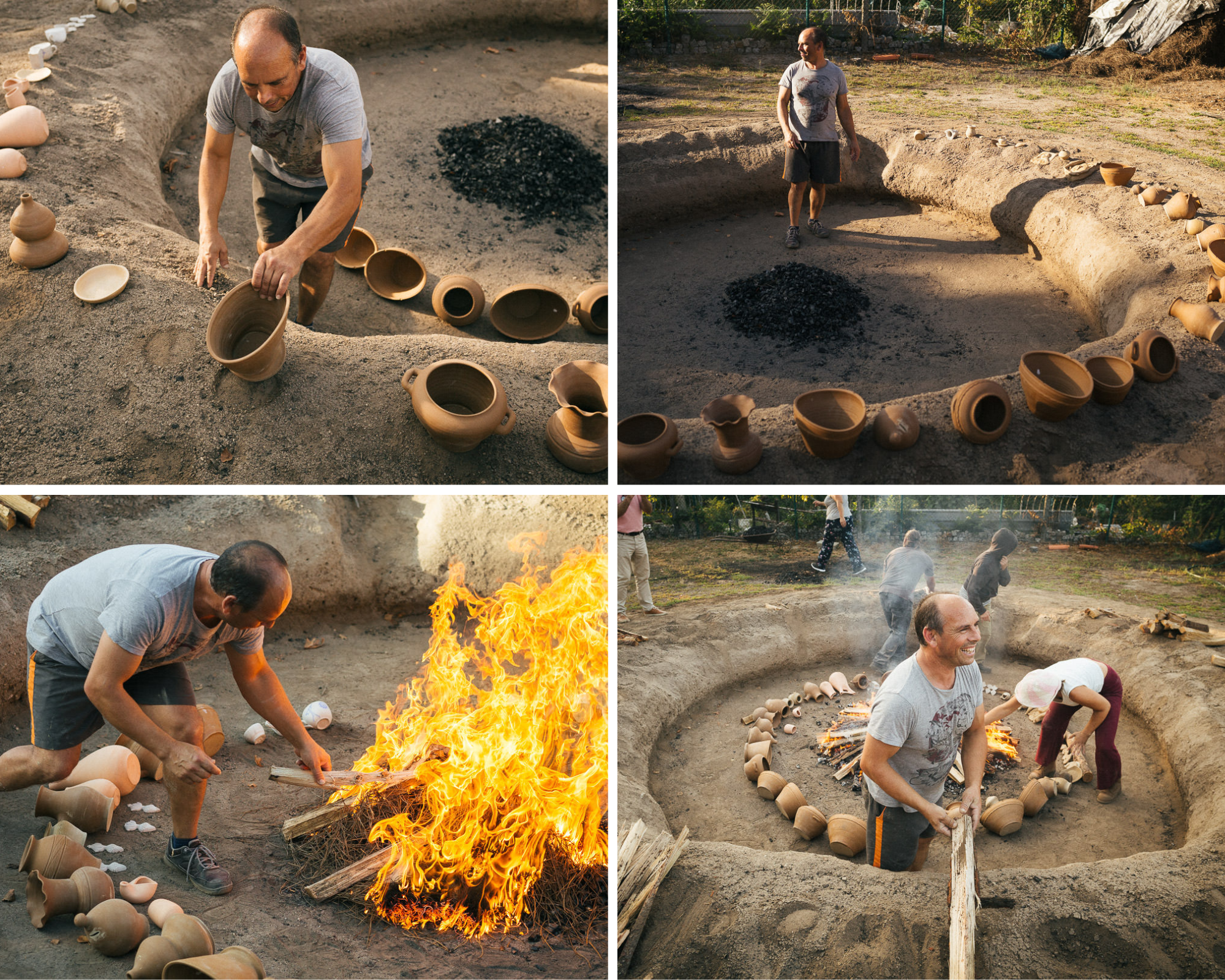THE MOTHER OF CRAFTS IS RAW MATERIAL

The materials that appear in nature are said to be the most durable and reliable for our health, since they derive from a natural production based on raw materials, elaborated by the Mother Nature. However, today these goods are increasingly scarce in their raw and organic form, leading to mass production. It is for this reason that the value of fauna and flora has been experiencing an enormous growth, as demand increases and supply remains the same, with soil quality being impaired due to the large addition of chemicals and non-biodegradable products that affect biodiversity.

With the introduction of new technologies, a new vision of the concept of handicraft has emerged, a new hand-embroidered world, coming to outline new trends that accentuate and contradict others. For example, that of ceramics that has been developing through workshops and ateliers — activities to which people have adhered very well, either because it is calm and soothing manual work, as it is inexpensive and mentally constructive. It has become a form of new therapy for the 21st century.

@a_casadoazulejo
This new wave of craftsmanship (an art that has existed since antiquity) came to transform contemporary art, contributing to a kind of re-education in manufacturing and mechanical savoir-faire. It's a return to the origins in its simplest and purest form of confection, making each piece (again) unique, singular, different, like each task (more) valued and prestigious, recognized and admired. All of this in a single act: craftsmanship.

@a_casadoazulejo & Pinterest Images
It's this form of manual wisdom that I am trying to convey today with Luz Editions. Relying on tradition, Portuguese know-how and its natural wealth, I draw raw materials from nature and try to create pieces with the least possible consequences for our planet.
POTTERY AND BARRO NEGRO (BLACK CLAY), A MODERN TONE
The clay is originally white but it is possible to blacken it, making it authentic and refined. Originally, clay was baked in an ancestral way using the soenga technique, that is to say, firing pottery in a shallow pit covered with earth and wood. Nowadays, this tradition is still active but takes place on specific dates as a celebration. Currently, in the case of our candles, the pieces are fired in a wooden oven which replaces this tradition but reproduces the same process.

Soenga Technique by César Teixeira, ©A Arte Popular Portuguesa
"First, a hole is opened in the ground, a fire is made and the clay pieces are placed there. During cooking, when the temperature is ideal, the pieces are covered with pine needles and soil to stifle the fire". By cutting off the oxygen (smothering process) the smoke penetrates inside the pieces, they gain the black color and thus black clay is born.

Soenga Technique by César Teixeira, ©A Arte Popular Portuguesa

Pinterest Images
This method is still applied in some villages in the North of Portugal, however not very widespread, on the verge of being forgotten. For this reason, as well as the beauty of the process and the desire to keep it alive, I wanted to keep the flame burning by adding one of my most fragrant Luz creations to the black clay recipe: the black clay candles.
Black Clay Candles, Luz Editions
Based on soy wax and natural aromas extracted in Grasse (France), the candles are hand poured in unglazed black clay vessel, allowing the aroma of the candle to diffuse to the outside its fragrance in a smooth and light way.
PORCELAIN, AN HERITAGE TURNED INTO MODERNITY
Created in China, initially prepared from a process of firing two ores, feldspar and kaolin, porcelain stands out for three factors: its resistance, whiteness and translucency, which gives it a unique shine. On his trip to Asia, Marco Polo discovered porcelain and brought it to Europeans in 1295.

Pinterest Images
"Its mechanical resistance and high density make it durable, harmless, soft to the touch and very aesthetic", combining usefulness with pleasantness in everyday tasks. Not to be confused with earthenware or stoneware, as porcelain porosity is zero, practically impermeable, not absorbing the elements to which it is exposed. This factor makes it extremely hygienic, ideal for very frequent use. "It has a varnish applied after firing that adheres to the material, forming a covering film, resulting in pure white coloring pieces".

Pinterest Images
Its delicacy and beauty dance with elegance and timelessness, suitable for any event.

Paixão plate, Luz Editions
 Viana and Serpa Pendant lights
Viana and Serpa Pendant lights
Faithful to the Portuguese tradition of porcelain, Luz Editions has created a collection of 4 plates based on the humorous symbols of the country.
In another area, a collection of pendant lights with fine and discreet finishes and an elegant design has also been created and brings life and delicacy to any interior that wants to be different.
In another area, a collection of pendant lights with fine and discreet finishes and an elegant design has also been created and brings life and delicacy to any interior that wants to be different.
STONEWARE, PORCELAIN'S SISTER
Made from single-fired clay, which can reach high temperatures, stoneware has a great absorption capacity, has a high level of porosity, in addition to being quite resistant to chemical substances — hence it is suitable for productions aimed at tableware.

Pinterest Images
Many confuse him with his sister porcelain, but they are not the same. Stoneware has a denser appearance, with a greater variety of minerals in its composition. Its charm lies in the imperfection of its structure. We speak of white and limpid skin for porcelain, but for stoneware the opposite applies: the beauty of its irregularities that come to harmonize a whole.
Malgas, Luz Editions
Our malgas (bowls) show this same virtue: the charm of the alternating colours, tones and irregularities of the stoneware; a passion that takes us back to the tradition of bread soaked in soup or coffee on an appetizing afternoon in these bowls with a concave curve that are bowls. Stories have long been told about the simplicity of Portuguese living.
LINEN ALWAYS WANTS TO KEEP THE LINE
From the linaceae family, flax covers a large part of Portuguese culture. Its seed is linseed, widely used in cooking, where it is consumed in the shell, extracting linseed oil, rich in omega-3, 6 and 9 oil".
Linen "is composed of a fibrous substance, from which its long fibers are extracted for the manufacture of fabrics".
Linen "is composed of a fibrous substance, from which its long fibers are extracted for the manufacture of fabrics".

Google Images
It was precisely to preserve the history of this very old textile that I chose linen for the manual manufacture of my cloths. They are so different from each other, silkscreened one by one with an image by the talented photographer Artur Pastor — from whom I was inspired when creating Luz Editions —, as well as a text that I wrote to translate the emotion of these images.
Linen Cloths, Luz Editions @Stephane Gaillard
Portugal is, therefore, a library of beautiful stories that appeal to the various traditions and cultural standards cherished by an earlier era, in addition to all the scenic beauty that it inspires and the affable and spontaneous people that exhales.

Pinterest Images
GET TO DISCOVER PORTUGAL THROUGH LUZ!
Ref: National Geographic Portugal, Wikipedia, Amarante Tourism, Infusões com História, Costa Verde, A Arte Popular Portuguesa




